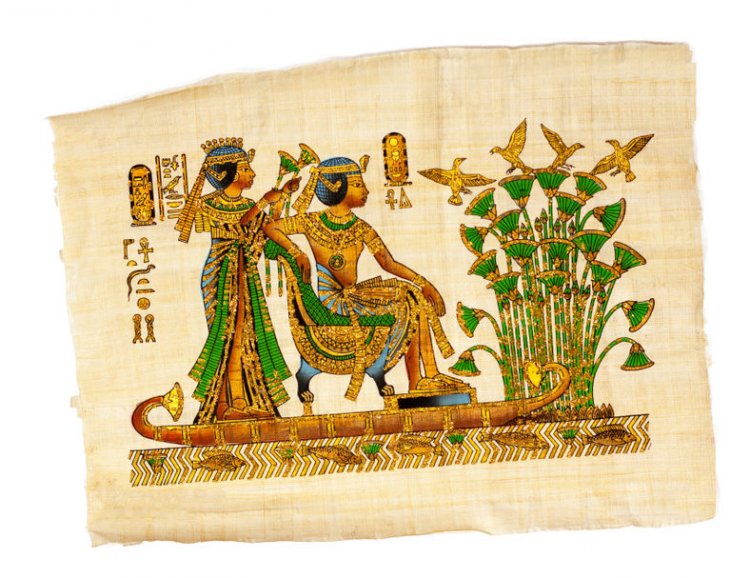You’re reading this from a screen. The popularity of electronic texts is steadily growing, especially in the news agenda. If we talk about books, the latest polls show that most Russians prefer to read them in paper rather than electronic form: about 54% vs 30%. The debate about whether an electronic medium could replace the rustle of pages being turned remains popular, but history demonstrates that over time people move to more convenient and advanced carriers of written information.
The Egyptian roots
“Paper” in English, “papier” in French, “papel” in Spanish, “papir” in Czech – the common root refers to the material on which written information was stored and transmitted long before our era – papyrus. It was used in ancient Egypt for at least three millennia before our era, and later the material became popular throughout the ancient world.
Papyrus is a plant from the sedge family, also known as paper reed. The stems are about 7 centimeters thick and reach 4–5 meters in height. It is unclear how exactly the ancient Egyptians made writing material from a plant – there were either no written or visual descriptions of the technical process, or they have not been preserved. One of the sources of information about papyrus production is “Natural History” by Pliny the Elder, an ancient Roman writer. And it was written only at the beginning of our era: thousands of years passed from the beginning of the production of papyrus scrolls to its writing. However, there is a mention of the process in it; its translation is given by the Soviet historian Vladimir Borukhovich in his work “In the world of ancient scrolls.”
Papyrus
“In general, charta is always made on a wet table moistened with Nile water. Muddy Nile water enhances the adhesive properties. First, the lower schida is placed, the entire length of the future papyrus sheet; the prominent ends are cut off. Then a perpendicular one is placed on top of it, which creates a ‘grid.’ The entire charta is pressed with a press, then the charta is beaten off with a hammer and smeared with glue: wrinkled, it is stretched again and leveled with a hammer. The resulting sheets are dried in the sun and joined together so that the best sheets are glued together with similar ones. The quality of the sheets deteriorates as we approach the end of the entire scapa. No more than 20 sheets are connected to the scapa.”
The material identical to the ancient papyrus was produced later after a solution was experimentally found. First, the freshly cut papyrus stalks were soaked in water and the green peel was removed. The softcore was cut into strips and laid out on the table close to each other, with the second layer on top, perpendicular to the first. The two layers under the load were glued together, due to the sticky substance of the plant itself. Then the finished sheet was dried, leveled, and smoothed. This process made it possible to make material that archaeologists find thousands of years later: the oldest papyrus with text is dated 1991–1783 BC.
An alternative to papyrus was invented 150 years before our era. Finely tanned, cleaned, and smoothed animal skins were called parchments after the city of Pergamon. Their more expensive production was compensated by increased strength. In addition, it was with the advent of parchment that books appeared in the form known today – it was easier to fold sheets of tanned leather than to roll them into scrolls, as was done with papyrus. Around the 12th century, both parchment and papyrus all over the world were replaced by cheaper paper, which by that time had undergone more than a thousand years of development.
The first sheets
The invention of paper dates to 105 AD, when a Chinese dignitary Cai Lun improved the production processes of paper-like materials and obtained strong sheets of writing material. It was Cai Lun who formed the sheets by depositing thin fibers diluted with water: he used wood ash, hemp, mulberry fibers, and old rags. He laid out the resulting mixture to dry on a bamboo frame, and then smoothed the material with stones.
Later, glue and natural dyes were added to the paper to increase its strength and quality. In the 4th century, bamboo shoots or reeds began to be added to the raw materials, the mass was washed and boiled with the addition of lime and ash, and evenly distributed on the drying grids to obtain even and smooth sheets. The technology of paper production was kept secret by China until the 600s. Then the method of its production became known in Japan, and later the Arabs launched its production in Baghdad, having captured Chinese paper craftsmen after the victory in the Battle of Talas.
The technology of paper production eventually became known all over the world, where it was improved and made cheaper. An important stage in the development of the paper industry was the invention of the roll – the machine that shredded, mashed, and mixed raw materials with water. Thus, a high-quality paper mass was obtained from small fibers, which became much faster to obtain. Often, water mills were used to produce paper: the wheel drove a shaft that shredded raw materials. This was the beginning of the process of automating the production of paper.
With the advent of the paper-making machine in 1799, the manual casting of sheets was discontinued, which significantly increased the speed of material production. The devices were constantly being improved: the first machines only formed sheets, but they had to be dried in the air. Later, all stages of production were automated.
Modern technologies
Every year, global manufacturers produce up to 400 million tons of paper and cardboard. And to this day, the devices that produce sheets are constantly being improved.
New technologies for drying sheets are being patented. One of the methods is the technology of pulse paper drying. One of the press shafts through which the sheet passes is heated to a temperature of about 400 degrees, and in less than a second, most of the moisture evaporates. Traditional drying by pressing is not suitable for the production of toilet paper and paper towels – when pressed, the paper becomes stronger and denser, but the absorbent properties and softness decrease. To solve this problem, the technology of through drying with hot air was developed. The air heated above 350 °C is blown through a paper cloth, which is fixed on a corrugated grid.
There are dozens of chemical reagents used to impregnate the paper. Most of them are used to increase the strength of the paper, make it smoother and whiter. The modern market offers grades of material for completely different purposes, depending on the required quality and further application. In most cases, impurities are added to the paper at the production stage of the raw material mass. For this purpose, water-repellent impregnations are used: the process is called hydrophobization of paper, and the main substance is rosin, which is obtained from the resin of coniferous trees.
“Paper” screen
You’re reading this from your phone or computer screen. One of the main disadvantages of such reading is the device’s rapidly draining battery. The relatively new e-ink technology is used in e-books, which are double-digits more energy efficient.
The principle of this technology is based on the phenomenon of electrophoresis: if you place a gel or liquid between the electrodes, the charged particles in the gel will “crawl” to the opposite electrode. In e-paper, a pixel corresponds to a small capsule with black or white charged particles. By manipulating the charge of the electrodes, you can control their movement: for example, you can force black particles to rise to the end of the capsule that is facing the user’s eyes. Thus, the energy in e-books is spent only on “page-flipping.”
Photo:sir270 / 123rf.com
Based on open sources






















